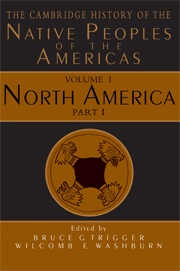Book contents
-
Frontmatter
- 1
Native views of history
- 2
Native peoples in Euro-American historiography
- 3
The first Americans and the differentiation of hunter-gatherer cultures
- 4
Indigenous farmers
- 5
Agricultural chiefdoms of the Eastern Woodlands
- 6
Entertaining strangers: North America in the sixteenth century
- 7
Native people and European settlers in eastern North America, 1600–1783
- 8
The expansion of European colonization to the Mississippi Valley, 1780–1880
-
Index
- References
3 - The first Americans and the differentiation of hunter-gatherer cultures
Published online by Cambridge University Press: 28 March 2008
- Frontmatter
- 1 Native views of history
- 2 Native peoples in Euro-American historiography
- 3 The first Americans and the differentiation of hunter-gatherer cultures
- 4 Indigenous farmers
- 5 Agricultural chiefdoms of the Eastern Woodlands
- 6 Entertaining strangers: North America in the sixteenth century
- 7 Native people and European settlers in eastern North America, 1600–1783
- 8 The expansion of European colonization to the Mississippi Valley, 1780–1880
- Index
- References
Summary
This chapter examines the evidence for the arrival of human beings in the Americas and the subsequent development of American Indian and Inuit hunter-gatherer societies in North America. Coverage ends with the rise of horticultural societies where that occurred, but continues to first contact with Europeans for much of North America. The chapter also explains how archaeologists build chronologies for periods prior to written records, and how colleagues in other disciplines reconstruct the environmental contexts of ancient societies.
APPROACHES TO THE PAST
Like human beings everywhere, all American Indians descend from people who were once full-time hunter-gatherers. Even those who eventually adopted more intensive subsistence strategies often retained hunting and gathering practices as regular supplements and insurance against occasional shortages. After European contact, many North American horticulturalists reverted to full-time hunting and gathering, as firearms and the reintroduced horse made the vast bison herds of the Great Plains more easily accessible. Thus hunting and gathering pervades the history of American Indian societies, providing the context for their initial expansion and subsequent differentiation. However, to carry an understanding of those processes beyond the simplistic stereotypes of popular history, some reassessment of basic concepts and review of archaeological theory is necessary.
- Type
- Chapter
- Information
-
The Cambridge History of the Native Peoples of the Americas , pp. 125 - 200Publisher: Cambridge University PressPrint publication year: 1996



